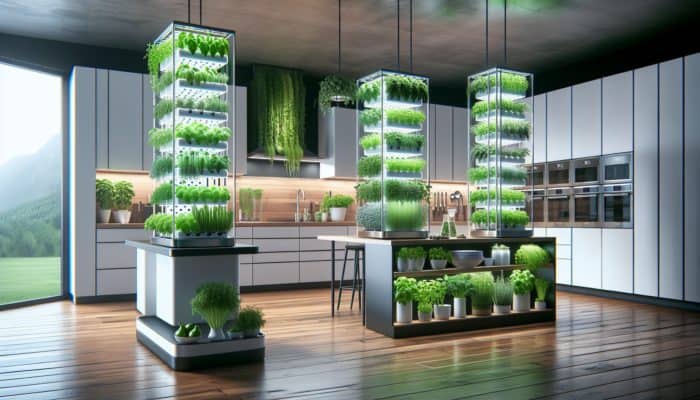Explore the World of Hydroponic Herbs for Culinary Excellence
What Exactly Are Hydroponic Herbs?

How to Cook with Hydroponic Herbs: Hydroponic herbs are remarkable plants that flourish in nutrient-rich water solutions instead of traditional soil. This advanced growing method enables the continuous cultivation of fresh herbs throughout the year, making them an ideal choice for those who enjoy cooking and gardening. Hydroponic herbs often possess intensified flavour profiles, which can significantly elevate your culinary creations. Common varieties of hydroponic herbs include:
- Basil
- Cilantro
- Mint
- Parsley
- Thyme
- Chives
- Oregano
- Dill
These herbs not only add vibrant flavours to your dishes but also enhance their visual appeal, bringing a touch of nature to your plate regardless of the season. By integrating hydroponic herbs into your cooking, both professional chefs and home cooks can unlock an expansive realm of culinary creativity.
Advantages of Cooking with Hydroponic Herbs
The incorporation of hydroponic herbs into your culinary repertoire offers numerous benefits that enhance your cooking experience while promoting sustainability. One significant advantage is their robust flavour; many hydroponic herbs are more potent than their soil-grown counterparts. The carefully controlled environment in which these herbs are cultivated often leads to higher concentrations of essential oils and flavours. Other key benefits include:
- Year-round availability, irrespective of external growing conditions
- Reduced susceptibility to pests and diseases
- Minimal space requirements, perfect for indoor gardening
- Accelerated growth cycles, allowing for quicker harvesting
- Decreased reliance on herbicides and pesticides
These advantages not only cater to the needs of chefs but also appeal to environmentally conscious consumers seeking to reduce their carbon footprint. Cooking with hydroponic herbs can transform ordinary meals into extraordinary culinary adventures, making them a vital ingredient in any kitchen.
How to Create Your Own Hydroponic Herb Garden
Establishing your own hydroponic herb garden is a fulfilling endeavour that requires minimal space and can easily be accomplished indoors. Whether you're an experienced gardener or just starting, creating a hydroponic setup allows you to enjoy a steady supply of fresh herbs. To embark on this exciting journey, follow these essential steps:
- Select a hydroponic system (e.g., Deep Water Culture, Nutrient Film Technique, or Ebb and Flow)
- Choose the appropriate nutrient solution specifically designed for herbs
- Invest in suitable lighting, such as LED grow lights, to mimic sunlight
- Monitor key environmental factors like temperature and humidity
- Prepare a growing medium if necessary, such as rock wool or clay pellets
Setting up your garden can be a straightforward and gratifying project. Once established, it provides you with not only fresh ingredients for your culinary creations but also a rewarding hobby that connects you to your food source.
Essential Maintenance Tips for Your Hydroponic Herb Garden

The prosperity of your hydroponic herb garden depends on consistent maintenance and diligent monitoring. A thriving garden requires commitment and precise adjustments to nutrient levels, pH balance, and overall plant health. Key maintenance practices you should follow include:
- Regularly checking and adjusting nutrient levels in the water
- Maintaining optimal pH levels (around 5.5 to 6.5 for most herbs)
- Pruning to promote bushier growth and prevent overcrowding
- Ensuring adequate light exposure for healthy photosynthesis
- Inspecting plants for signs of pests or diseases
By dedicating time to these maintenance practices, you can cultivate a flourishing hydroponic herb garden that yields fresh, flavourful herbs ready to enhance your culinary masterpieces.
Expert Strategies for Cooking with Hydroponic Herbs
How Can Hydroponic Herbs Elevate Your Culinary Creations?
Adding hydroponic herbs to your meals can dramatically transform flavour profiles, bringing a freshness that often surpasses that of dried or store-bought alternatives. To effectively utilise hydroponic herbs, consider these actionable strategies:
- Use them as a garnish for salads and soups
- Infuse oils with freshly harvested herbs for dressings
- Add them to marinades for meat, fish, or tofu
- Blend herbs into sauces or dips for an added flavour boost
- Experiment with herb-based pestos or butters
These herbs have the potential to elevate traditional dishes and inspire innovative culinary experiments. The vibrant flavours of hydroponic herbs not only enhance the taste of your meals but can also turn simple recipes into extraordinary culinary experiences.
What Are the Top Hydroponic Herbs for Culinary Use?

In the culinary world, certain hydroponic herbs are renowned for their unique flavours and versatility. The best choices for cooking include:
- Basil: A staple in Italian cuisine, ideal for sauces and salads.
- Cilantro: A key ingredient in Mexican and Asian dishes, perfect for salsas and curries.
- Mint: Refreshing addition to beverages and desserts.
- Thyme: Enhances roasts and stews, adding depth to savoury dishes.
- Oregano: Essential for Mediterranean cuisine, elevating pizzas and pastas.
Incorporating these herbs can significantly uplift your recipes, delivering a burst of freshness that is difficult to achieve with dried alternatives. Embracing hydroponic herbs opens up a world of flavour possibilities, allowing you to innovate traditional recipes with a contemporary twist.
Practical Tips for Storing and Preserving Hydroponic Herbs
Proper storage and preservation techniques are crucial for maximising the shelf life of hydroponic herbs while retaining their vibrant flavours. Here are some effective methods:
- Refrigerate fresh herbs in a sealed container with a damp paper towel
- Freeze herbs in ice cube trays with water or oil for convenient use
- Dry herbs by hanging them upside down in a dark, cool place
- Store in airtight jars to minimise exposure to air and moisture
For example, freezing mint leaves in olive oil creates flavour-packed cubes that can enhance your cooking effortlessly. By employing these storage techniques, you can enjoy the full benefits of hydroponic herbs long after they are harvested.
Best Practices for Harvesting and Using Hydroponic Herbs
When Is the Optimal Time to Harvest Hydroponic Herbs?
The ideal moment to harvest hydroponic herbs is just before they begin to flower. At this stage, the flavour and essential oils are at their peak, offering the best taste for your culinary creations. Signs that your herbs are ready for harvesting include:
- Leaves are lush and vibrant
- Plants have reached an appropriate height for cutting
- Herb growth appears vigorous and bushy
- Flowers have not yet started to bloom
Regularly harvesting your plants encourages further growth, ensuring a continual supply of fresh herbs. For instance, cutting basil at the right moment can promote bushier plants, leading to more abundant future harvests. Understanding the best time to harvest can significantly enhance your culinary experience.
Techniques for Efficiently Harvesting Hydroponic Herbs
Harvesting hydroponic herbs requires careful techniques to encourage regrowth and maintain plant health. To effectively gather your herbs, keep these steps in mind:
- Utilise sharp scissors or garden shears for a clean cut
- Cut stems just above a leaf node to stimulate branching
- Avoid removing more than one-third of the plant at a time
- Harvest in the morning when the plants are most hydrated
For instance, cutting mint leaves just above the node encourages new growth, allowing you to harvest regularly without harming the plant. These harvesting techniques promote a healthy, thriving hydroponic garden while ensuring you have fresh herbs readily available.
How to Incorporate Freshly Harvested Herbs into Your Recipes
Freshly harvested hydroponic herbs can elevate ordinary recipes into culinary masterpieces. Their vibrant flavours lend depth and freshness, making them essential ingredients in a variety of dishes. To maximise flavour when using fresh herbs, consider these techniques:
- Add herbs at the end of cooking to preserve their potency
- Use them as garnishes for a visually appealing presentation
- Mix fresh herbs into dressings or dips for an aromatic kick
- Incorporate into cooked dishes just before serving
For example, adding fresh basil to a tomato salad immediately before serving significantly enhances the flavours. This approach allows you to savour the full spectrum of tastes that hydroponic herbs bring to your meals, transforming each dish into a delightful culinary experience.
What Are the Key Benefits of Cooking with Hydroponic Herbs?
Nutritional Advantages of Hydroponic Herbs
Hydroponic herbs are not only flavourful but also packed with essential nutrients, making them a valuable addition to any diet. Thanks to the controlled growing conditions, they often contain higher concentrations of vital vitamins and minerals. Specific nutrients commonly found in hydroponic herbs include:
- Vitamin C (present in parsley and cilantro)
- Vitamin K (prominent in basil and mint)
- Iron (abundant in dill and oregano)
- Antioxidants (found in many fresh herbs)
Incorporating these nutritional powerhouses into your meals can significantly boost your overall health and well-being. For instance, using fresh cilantro in your dishes not only elevates flavour but also enhances your intake of essential nutrients.
Environmental Benefits of Choosing Hydroponic Herbs
The cultivation of hydroponic herbs presents a sustainable alternative to traditional agriculture, substantially reducing the environmental impact associated with herb production. Hydroponic systems consume less water and require less space, while also minimising the use of harmful pesticides and herbicides. By opting for hydroponic herbs, you contribute to more sustainable culinary practices. Key environmental advantages include:
- Lower water consumption compared to soil farming
- Reduced carbon footprint from local production
- Less land use, facilitating urban gardening
- Minimised chemical use, promoting safer food sources
Cooking with hydroponic herbs allows you to enjoy fresh flavours while supporting environmentally friendly practices. By adopting this approach, you contribute to a healthier planet while nourishing yourself and your loved ones.
Cost-Effectiveness of Cultivating Hydroponic Herbs
Growing hydroponic herbs at home can lead to substantial cost savings compared to purchasing fresh herbs from stores regularly. While there may be an initial investment in setting up a hydroponic system, the long-term benefits far exceed this cost. Some strategies for saving money with hydroponic herbs include:
- Reducing the frequency of grocery store visits for fresh herbs
- Lowering overall food waste by harvesting only what you need
- Utilising your herbs in a variety of dishes to maximise their use
- Sharing excess herbs with friends and family, fostering community
By cultivating your own hydroponic herbs, you not only gain access to fresh ingredients at your fingertips but also reap financial rewards over time. This approach empowers you to create delicious meals while being mindful of your budget.
Research-Backed Benefits of Cooking with Hydroponic Herbs
What Do Studies Reveal About Flavour Enhancement with Hydroponic Herbs?
Research shows that hydroponic herbs can enhance the flavour of dishes more effectively than those grown in soil. This is primarily due to the controlled growing conditions, which enable the plants to develop higher concentrations of essential oils. For chefs, utilising hydroponic herbs can significantly enhance the flavour of dishes. Real-world examples of enhanced flavour include:
- Fresh basil in Caprese salads
- Cilantro in authentic Mexican salsas
- Mint in refreshing mojitos
- Thyme in roasted vegetables
Each of these dishes demonstrates how hydroponic herbs can elevate culinary experiences, resulting in more satisfying and flavorful meals. As culinary professionals continue to explore the potential of hydroponic herbs, their applications are becoming increasingly innovative and diverse.
Health Benefits Associated with Hydroponic Herbs in Cooking
Incorporating hydroponic herbs into your cooking can offer numerous health benefits, making them a valuable component of a balanced diet. These herbs are often associated with improved digestion, enhanced immune function, and antioxidant properties. You can harness these benefits by:
- Adding fresh herbs to salads and smoothies for added nutrients
- Using them in marinades for meat, enhancing both flavour and health
- Infusing herbal teas for digestive support
- Incorporating herbs into soups for nourishing cold remedies
By incorporating hydroponic herbs into your daily meals, you can not only enhance the flavour but also the nutritional value of your dishes, contributing to a healthier lifestyle.
How Do Hydroponic Herbs Inspire Culinary Creativity?
Hydroponic herbs can significantly inspire culinary creativity, providing chefs with a constant supply of fresh flavours to experiment with. The versatility of hydroponic herbs encourages innovation in the kitchen, urging chefs to push culinary boundaries. Here are ways hydroponic herbs foster creativity:
- Encouraging new flavour combinations and pairings
- Inspiring unique recipes that incorporate seasonal herbs
- Promoting experimentation with modern cooking techniques
- Facilitating the creation of signature dishes
For instance, a chef might blend hydroponic mint into a traditional chimichurri, creating a refreshing twist on a classic sauce. The consistent availability of fresh herbs inspires cooks to innovate, resulting in innovative gastronomic creations that enhance the culinary landscape.
How to Pair Hydroponic Herbs with Various Cuisines
Pairing Hydroponic Herbs with Traditional Culinary Dishes
Hydroponic herbs can enrich traditional dishes by introducing fresh flavours that enhance authenticity and taste. For example, fresh basil can dramatically elevate Italian pasta dishes, while cilantro can deepen the complexity of many Latin American flavours. Other examples include:
- Thyme in French ratatouille
- Oregano in Greek tzatziki
- Mint in Middle Eastern tabbouleh
- Parsley in classic European sauces
Incorporating hydroponic herbs into these traditional recipes not only honours cultural heritage but also revitalises them with fresh ingredients, taking beloved dishes to new heights.
Hydroponic Herbs in International Culinary Traditions
Hydroponic herbs can seamlessly integrate into a variety of international cuisines, adding unique flavours that enhance dishes from around the globe. They play a crucial role in creating authentic taste experiences. For example, in Asian stir-fries, fresh basil or mint can brighten the dish, while in Indian curries, cilantro adds a refreshing finish. Other uses include:
- Mint in Moroccan tagines
- Basil in Vietnamese pho
- Oregano in Italian focaccia
- Chives in Korean dishes
By leveraging the distinct flavours of hydroponic herbs, home cooks and chefs alike can bring international cuisine to life, creating dishes that are both authentic and exciting.
Innovative Applications of Hydroponic Herbs in Contemporary Cooking
Modern cooking frequently embraces innovative uses of hydroponic herbs, capitalising on their potential to create complex flavour profiles. Techniques such as molecular gastronomy and fusion cuisine are redefining how herbs can be employed. Some innovative applications include:
- Infusing oils or spirits with fresh herbs for cocktails
- Creating herb-infused syrups for desserts
- Using hydroponic herbs in foam or gel forms
- Incorporating herbs into unique marinades or dressings
Chefs are pushing culinary boundaries by using hydroponic herbs as essential ingredients that infuse contemporary flair into their creations. Their versatility enhances both traditional and modern dishes, leading to unexpected flavour combinations that delight the palate.
Seasonal Pairing of Hydroponic Herbs with Different Cuisines
Hydroponic herbs can be beautifully paired with seasonal cuisines, allowing for fresh, timely flavours that resonate with the current season. This alignment can enhance the overall dining experience by providing herbs that complement seasonal ingredients. For example:
- Fresh basil in summer salads
- Cilantro in autumnal soups
- Thyme in winter stews
- Mint in spring desserts
Aligning hydroponic herbs with seasonal dishes not only elevates flavour but also showcases the natural bounty of each season, making meals more enjoyable and relevant to the time of year.
Expert Tips and Tricks for Cooking with Hydroponic Herbs
Maximising Flavour with Hydroponic Herbs
To fully experience the robust flavour of hydroponic herbs, consider using them strategically in your cooking. These herbs are best added towards the end of the cooking process or used as a garnish. Techniques to maximise flavour include:
- Chopping herbs finely to release more oils
- Mixing them into dishes just before serving
- Using herbs in dressings for an aromatic punch
- Experimenting with pairing herbs based on complementary flavour profiles
For instance, adding finely chopped parsley to a hearty stew right before serving can enhance its flavour without losing the herb's freshness. This technique ensures that the natural oils and flavours remain vibrant, elevating your culinary creations.
Balancing Flavours with Hydroponic Herbs
Hydroponic herbs can play a pivotal role in balancing flavours within your dishes. Fresh herbs can counterbalance rich or heavy ingredients, leading to a more harmonious overall taste. Techniques for achieving flavour balance include:
- Using fresh herbs to lighten creamy sauces
- Incorporating mint to offset spicy elements
- Adding thyme to enrich savoury dishes
- Complementing sweet ingredients with basil or cilantro
For example, a rich, creamy pasta can benefit from the addition of fresh basil, which brightens the dish and enhances its overall flavour profile. By understanding how to balance flavours, you’ll create dishes that are more complex and satisfying.
Common Mistakes to Avoid When Using Hydroponic Herbs
While hydroponic herbs can greatly enhance your cooking, there are common pitfalls to avoid. Overusing herbs can overpower a dish, while using them too early in the cooking process can diminish their flavour potential. Key mistakes to watch out for include:
- Adding herbs too early, leading to a loss of flavour
- Using dried herbs instead of fresh for maximum potency
- Overwhelming a dish with too many herbs
- Neglecting to pair herbs with complementary flavours
By being mindful of these common mistakes, you can ensure that hydroponic herbs contribute positively to your culinary creations, enhancing rather than overpowering your dishes.
Pairing Hydroponic Herbs with Various Culinary Traditions
Hydroponic herbs offer remarkable versatility, allowing you to explore and enhance various culinary traditions. By understanding the unique flavour profiles of different herbs, you can create dishes that resonate across diverse cuisines. Consider how hydroponic herbs can complement:
- Italian cuisine with basil and oregano
- Asian dishes with cilantro and mint
- Middle Eastern flavours with parsley and dill
- French recipes with thyme and chives
By thoughtfully pairing hydroponic herbs with the right cuisines, you’ll elevate your cooking and create meals that are both authentic and flavourful. Embrace the possibilities that hydroponic herbs offer, allowing them to enhance each dish uniquely.
Effective Storage and Preservation of Hydroponic Herbs
Employing effective storage and preservation techniques for hydroponic herbs is essential for maintaining their freshness and potency. Using the right methods can ensure that your herbs remain flavourful for an extended period. Key storage strategies include:
- Refrigerating herbs in an airtight container with moisture
- Freezing herbs in oil or water for future use
- Drying herbs by hanging them upside down in a cool area
- Utilising herb storage systems designed to maintain freshness
For example, freezing fresh basil in ice cube trays makes it easy to add flavour to sauces and soups throughout the year. By adopting these storage strategies, you can enjoy the vibrant flavours of hydroponic herbs long after they’ve been harvested.
Frequently Asked Questions About Hydroponic Herbs
What are hydroponic herbs?
Hydroponic herbs are plants cultivated in nutrient-rich water instead of soil, providing fresh flavours and year-round availability.
What advantages do hydroponic herbs offer in cooking?
Hydroponic herbs are often fresher, more potent, and can be grown indoors, ensuring a constant supply for your culinary needs.
How do I establish a hydroponic herb garden?
To create a hydroponic herb garden, select a system, choose nutrients, ensure proper lighting, and monitor environmental conditions.
What steps are necessary for maintaining my hydroponic herb garden?
Regular maintenance includes checking nutrient levels, adjusting the pH, and pruning to promote healthy growth.
How can hydroponic herbs enhance my culinary dishes?
Hydroponic herbs provide vibrant, fresh flavours that elevate the taste of a variety of dishes and inspire culinary creativity.
Which hydroponic herbs are best for cooking?
Popular hydroponic herbs include basil, cilantro, mint, and thyme, each offering unique flavours for various culinary applications.
What are effective methods for storing and preserving hydroponic herbs?
Store hydroponic herbs in the refrigerator, freeze them in oil, or dry them to maintain flavour and freshness.
When is the best time to harvest hydroponic herbs?
The optimal time for harvesting is just before flowering, when the flavour is most potent and vibrant.
What common mistakes should I avoid when using hydroponic herbs?
Common mistakes include adding herbs too early, overusing them, or failing to balance flavours appropriately.
How do I pair hydroponic herbs with different cuisines?
Hydroponic herbs can complement various cuisines; for example, basil pairs well with Italian, while cilantro enhances Asian dishes.


